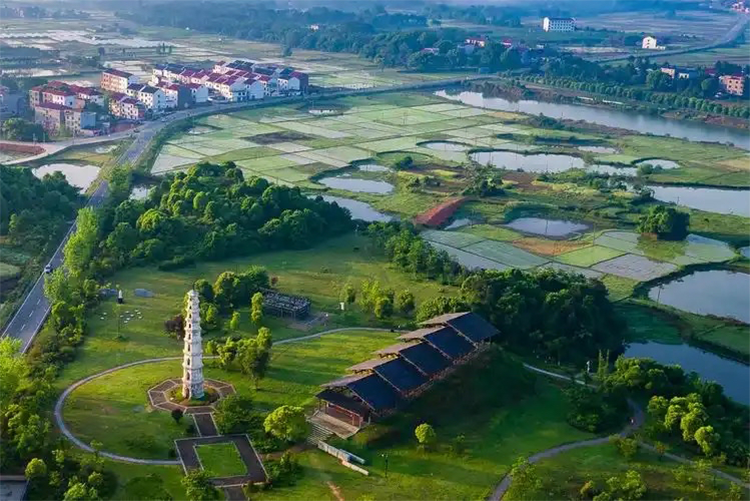Explore Jizhou Kiln: A Visitor’s Guide to Song-Yuan Black-Glaze Treasures
Introduction
When your fingertips trace the wood-leaf patterns fired into a tea cup, you can almost hear Southern Song scholars discussing tea and picture Silk Road ships carrying black-glaze wares across the waves. Jizhou Kiln — a millennium-old site hidden among Jiangxi’s green hills and clear streams — tells a vivid innovation story through 24 sleeping kilns and countless colorful shards.
1. Song–Yuan Folk Kiln Peak: The “Poetic Revolution” of Black Glaze
“Heaven’s eye glaze hides the universe; in a wood-leaf cup you see seasons.” This old saying captures Jizhou Kiln’s spirit. As one of the three great folk kilns alongside Longquan and Jian, Jizhou lacked the ornate formality of imperial kilns but sparked a pottery aesthetic revolution with plain, natural black-glaze ware.
Unique techniques:
– Wood-leaf Tenmoku cups: Fresh mulberry leaves are dipped in glaze and applied to the clay body. After firing the leaf veins remain crisp; when tea is poured the cup appears to float autumn leaves on the surface.
– Tortoiseshell glaze: Carefully controlled firing produces turtle-shell patterns; each piece is an unrepeatable kiln-variation masterpiece.
– Paper-cut applique: Local paper-cutting designs were transferred to ceramics, an early fusion of folk art and pottery decoration.
At the Jizhou Kiln Museum thousands of excavated artifacts — from wood-leaf Tenmoku cups to partridge-spot pouring vessels — silently show how 800 years ago local craftsmen used humble materials to create the Zen aesthetics that even tea master Sen no Rikyū admired.
2. Walking the Ruins Park: A Time-and-Space Dialogue of 24 Kiln Mounds
The national archaeological park covers 2.8 square kilometers and is the best-preserved ancient folk-kiln complex in Asia. Stroll the grounds and you’ll encounter:
Living ceramic history:
– Dragon kiln remains: A hundred-meter-long hill-built kiln hints at the Song-era spectacle where a single firing produced thousands of pieces.
– Benjue Temple Pagoda: A six-sided, seven-story brick pagoda from the Song contains many Jizhou shards embedded in its bricks — a true “ceramic gene bank.”
– Qingdu Temple Ming-dynasty murals: Rare paintings that depict export pottery scenes and testify to the Silk Road’s maritime trade.
Visit early morning or at dusk. When slanted sunlight hits the exposed kiln walls, the glassy kiln-hearth residues refract rainbow hues as if the ancient fires still glow.

3. Deep Experience: Be a Song-Dynasty Potter for a Day
Jizhou Kiln avoids static museum displays and offers immersive experiences:
Hands-on history:
– Traditional throwing: Under an instructor’s guidance use Song-style tools to shape a porcelain blank and feel the ancient craft wisdom “hands following clay.”
– Wood-leaf applique workshop: Learn to turn fresh leaves into permanent ceramic patterns (best May–September when leaves are abundant).
– Kiln-opening reenactment: On the first and fifteenth day of the lunar month visitors can watch a recreated dragon-kiln firing, and witness the surprise of “one kiln, many colors.”
4. Practical Guide: How to Start Your Ceramic Pilgrimage
Transport:
– By car: About a two-hour drive from Nanchang via Zhangji–Ji expressway; free parking at the site.
– High-speed rail + bus: Take high-speed train to Ji’an West Station, transfer to Bus 501 to the “Jizhou Kiln Ruins” stop (total about 1.5 hours).
Visitor tips:
– Suggested route: Museum (1h) → Core ruins (2h) → Intangible heritage workshop (1.5h) → Benjue Temple Pagoda (0.5h).
– Best season: Spring and autumn (March–May and September–November); avoid high noon heat in summer.
– Tickets: ¥60 (includes museum and ruins); students half-price; free admission every Wednesday.
Special notes:
– Free Chinese guided tours at 10:00 and 15:00 daily; English audio guides require advance reservation.
– The exit street, Yonghe Ancient Street, offers local snacks like Ji’an fried rice noodles and kiln-worker biscuits.

Final Words
Hold a re-fired wood-leaf Tenmoku cup at sunset and watch tea ripple golden on its thousand-year patterns; you’ll understand why Jizhou Kiln is called a “poetry in clay.” This site is not only a mecca for ceramics lovers but a cultural secret for anyone wanting to touch Chinese craftsmanship. Book a pottery session and let your fingerprints meet the marks left by artisans eight centuries ago.


